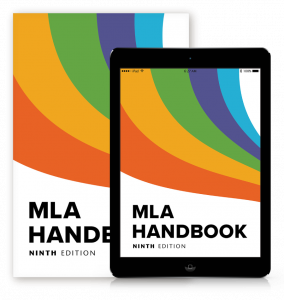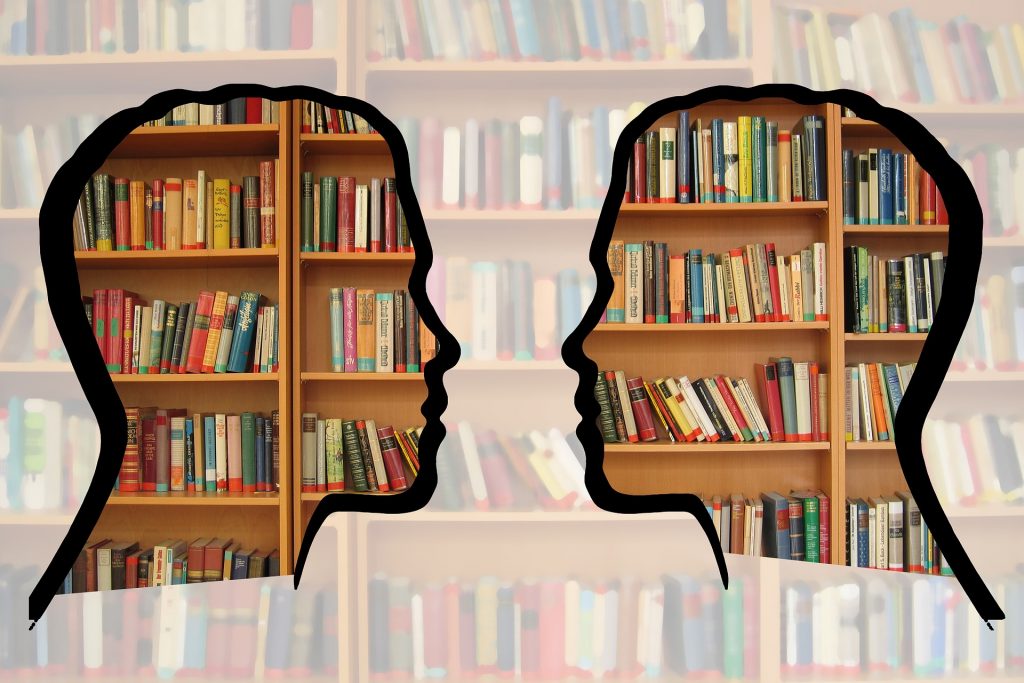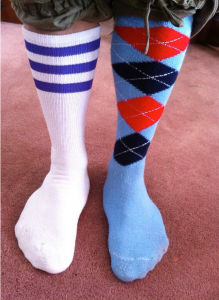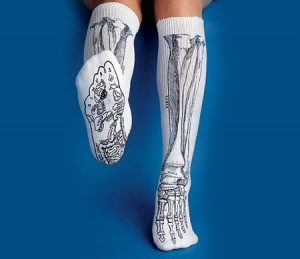After completing this chapter, you will be able to:
- Create a works cited list using MLA style.
In MLA Style, there are two components to every citation:
- A works cited list entry
- An in-text citation
Works Cited List Entry
The works cited list goes at the end of your paper. It contains longer citations that provide enough information to describe and find your source. For example, here is a citation for a book:
Dolmage, Jay Timothy. Academic Ableism: Disability and Higher Education. U of Michigan P, 2017. JSTOR, https://jstor.org/stable/j.ctvr33d50.
In-text Citation
Whenever you use words or ideas from a source in your text, you need to add an in-text citation. It includes the author last name(s) and the page number (or other location) where the information can be found within the source. For example:
(Dolmage 46)
We will explore each of these citation components, first separately and then together. First, we will discuss the works cited list.
What is a Works Cited List?
A works cited list is an alphabetized list, located on a separate page at the end of your paper, that lists all the citation details for the sources used in your paper.
Elements of Citation
MLA uses nine core elements for citing sources, but you usually do not need to use all of them for a single source. Click on each element below to learn more about it and how it is formatted.
An interactive H5P element has been excluded from this version of the text. You can view it online here:
https://openeducationalberta.ca/mla-tutorial/?p=48#h5p-1
Using MLA Resources to Create Citations
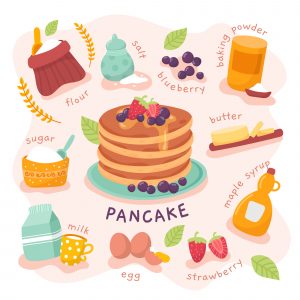
You’re not expected to memorize MLA guidelines. Instead, use available resources (e.g., U of A MLA QuickGuide (PDF), NorQuest College MLA 9 Research Guide, and this tutorial) to help guide you. Over time, you will become more comfortable with creating citations.
Using MLA resources to help create a works cited list entry is like using a recipe. The ingredients are the key pieces of information about a source (core elements). If you’re missing an ingredient, leave it out or substitute it.
Next, we will use the 9 core elements of citation to explore how to cite different types of sources.
Image attribution
“Pancake recipe with ingredients Free Vector” by pikisuperstar is licensed under CC BY 4.0 International.
Books are a key type of information source when you’re doing scholarly research. Click through the slides below for information about each element of a book citation, along with images of where you can find each element within a source.
An interactive H5P element has been excluded from this version of the text. You can view it online here:
https://openeducationalberta.ca/mla-tutorial/?p=126#h5p-2
Book Citation Examples
Next, let’s look at some examples of different types of book citations.
Print Book
A print book is a physical copy of a book (as opposed to an ebook). To cite this type of source, you usually only need about four or five different elements.
Steussy, Joe, and Scott Lipscomb. Rock and Roll: Its History and Stylistic Development. 7th ed., Pearson, 2013.
The example above includes these citation elements:
| Citation Element |
Example |
| Authors. |
Steussy, Joe, and Scott Lipscomb. |
| Title of Source. |
Rock and Roll: Its History and Stylistic Development. |
| Version, |
7th ed., |
| Publisher, |
Pearson, |
| Publication Date. |
2013. |
EBook
An ebook might be located on a website or in a library database, or it might be a file that you download. This example is for an ebook in a library database.
Dolmage, Jay Timothy. Academic Ableism: Disability and Higher Education. U of Michigan P, 2017. JSTOR, https://jstor.org/stable/j.ctvr33d50.
The example above includes these citation elements:
| Citation Element |
Example |
| Author. |
Dolmage, Jay Timothy. |
| Title of Source. |
Academic Ableism: Disability and Higher Education. |
| Publisher, |
U of Michigan P, |
| Publication Date. |
2017. |
| Container, |
JSTOR, |
| Location. |
https://jstor.org/stable/j.ctvr33d50. |
Edited Book
In an edited book, each chapter is written by a different author, and one or more editors is responsible for the book as a whole. If you are citing an entire edited book, the citation should start with the editor name(s).
Froggatt, Katherine, et al., editors. Understanding Care Homes: A Research and Development Perspective. Kingsley, 2009.
The example above includes these citation elements:
| Citation Element |
Example |
| Authors. |
Froggatt, Katherine, et al., editors. |
| Title of Source. |
Understanding Care Homes: A Research and Development Perspective. |
| Publisher, |
Kingsley, |
| Publication Date. |
2009. |
Citing Book Chapters
Sometimes you might want to cite one chapter or section of a book. Click through the slides below to learn about each element of a book chapter citation.
An interactive H5P element has been excluded from this version of the text. You can view it online here:
https://openeducationalberta.ca/mla-tutorial/?p=126#h5p-3
The following example shows a print book chapter citation, followed by a list of its elements.
Charters, Ann. “Beat Poetry and the San Francisco Poetry Renaissance.” The Columbia History of American Poetry, edited by Jay Parini and Brett C. Millier, Columbia UP, 1993, pp. 581-604.
The example above includes these citation elements:
| Citation Element |
Example |
| Author. |
Charters, Ann. |
| Title of Source. |
“Beat Poetry and the San Francisco Poetry Renaissance.” |
| Container, |
The Columbia History of American Poetry, |
| Contributors, |
edited by Jay Parini and Brett C. Millier, |
| Publisher, |
Columbia UP, |
| Publication Date, |
1993, |
| Location. |
pp. 581-604. |
Media attribution
Presentation slides adapted from Library Research Skills for First Year Seminar Students by Augustana Campus Library, licensed under CC BY-NC-SA 4.0.
You might use multiple different types of articles in your research. Some of the most common types are journal articles, news articles, and magazine articles. For online works, especially journal articles, you may come across a digital object identifier (DOI), which is a unique series of numbers and letters assigned to the article by the publisher. DOIs are more stable than URLs, so if a work has one, you should use it instead of a URL in your works cited list entry.
Click through the slides below to learn about each element of an article citation.
An interactive H5P element has been excluded from this version of the text. You can view it online here:
https://openeducationalberta.ca/mla-tutorial/?p=128#h5p-5
Article Citation Examples
Now we can look at examples of different types of article citations.
Journal Article
A journal article might be located in a library database or on a publisher’s website, or in some cases, in a print issue of the journal. The format will help determine which elements you should include in the citation. The following example is for an article in a library database that has a digital object identifier (DOI).
Antonie, Luiza, et al. “Full-Time and Part-Time Work and the Gender Wage Gap.” Atlantic Economic Journal, vol. 48, no. 3, 2020, pp. 313-326. EBSCOhost, https://doi.org/10.1007/s11293-020-09677-z.
The example above includes these citation elements:
| Citation Element |
Example |
| Authors. |
Antonie, Luiza, et al. |
| Title of Source. |
“Full-Time and Part-Time Work and the Gender Wage Gap.” |
| Container 1, |
Atlantic Economic Journal, |
| Number, |
vol. 48, no. 3, |
| Publication Date, |
2020, |
| Location 1. |
pp. 313-326. |
| Container 2, |
EBSCOhost, |
| Location 2. |
https://doi.org/10.1007/s11293-020-09677-z. |
News Article
Just like a journal article, a news article might be in a library database, on a publisher’s website, or in a print issue of the publication. The following example is for an article on a publisher’s website.
Chaya, Lynn. “Keanu Reeves Reminisces About Growing Up in Toronto After Induction Into Canada’s Walk of Fame.” Edmonton Journal, 20 Dec. 2021, https://edmontonjournal.com/news/keanu-reeves-reminisces-about-growing-up-in-toronto-after-induction-into-canadas-walk-of-fame.
The example above includes these citation elements:
| Citation Element |
Example |
| Author. |
Chaya, Lynn. |
| Title of Source. |
“Keanu Reeves Reminisces About Growing Up in Toronto After Induction Into Canada’s Walk of Fame.” |
| Container, |
Edmonton Journal, |
| Publication Date, |
20 Dec. 2021, |
| Location. |
https://edmontonjournal.com/news/keanu-reeves-reminisces-about-growing-up-in-toronto-after-induction-into-canadas-walk-of-fame. |
Magazine Article
Some magazines have volume or issue numbers, like journals, while others might just give a month or season of publication. In your citation, you should include whichever elements are available for the article. The example below is for a print issue of a journal that gives the months and year of publication rather than an issue number.
Estroff Marano, Hara. “An Element of Protection: Magnesium is a Mineral Essential to Mental Health.” Psychology Today, May-Jun. 2016, pp. 29-30.
The example above includes these citation elements:
| Citation Element |
Example |
| Author. |
Estroff Marano, Hara. |
| Title of Source. |
“An Element of Protection: Magnesium is a Mineral Essential to Mental Health.” |
| Container, |
Psychology Today, |
| Publication Date, |
May-Jun. 2016, |
| Location. |
pp. 29-30. |
Media attribution
Presentation slides adapted from Library Research Skills for First Year Seminar Students by Augustana Campus Library, licensed under CC BY-NC-SA 4.0.
Audiovisual works can include a wide variety of sources such as films, TV episodes, online videos, music recordings, performances, and more. The citation elements vary depending on the source.
The slides below will guide you through the elements you might need for citations of audiovisual works.
An interactive H5P element has been excluded from this version of the text. You can view it online here:
https://openeducationalberta.ca/mla-tutorial/?p=130#h5p-7
Audiovisual Citation Examples
The next examples show citations of some common types of audiovisual sources.
Online Video
The following example is for a YouTube video. If there is not a clear named author, skip the author element and start with the title, like in this example. The individual who uploaded the video is included under the Contributor element.
“Literary Devices in Pop Culture.” YouTube, uploaded by bcwalden43, 11 Jul. 2012, https://youtu.be/U_pxfifB6Co.
The example above includes these citation elements:
| Citation Element |
Example |
| Title of Source. |
“Literary Devices in Pop Culture.” |
| Container, |
YouTube, |
| Contributor, |
uploaded by bcwalden43, |
| Publication Date, |
11 Jul. 2012, |
| Location. |
https://youtu.be/U_pxfifB6Co. |
Film
The following example is for a film watched on the Netflix app.
Room. Performance by Brie Larson, Element Pictures, 2015. Netflix app.
The example above includes these citation elements:
| Citation Element |
Example |
| Title of Source. |
Room. |
| Contributor, |
Performance by Brie Larson, |
| Publisher, |
Element Pictures, |
| Publication Date. |
2015. |
| Supplemental element (platform). |
Netflix app. |
Audio Recording
This example is for a podcast episode, streamed from the host’s website. The publisher name is excluded because it is the same as the container.
McMahon, Ryan. “A Letter to the Puzzle People.” The Red Man Laughing Podcast, season 8, 14 Apr. 2020, https://redmanlaughing.squarespace.com/listen/2020/4/red-man-laughing-a-letter-to-the-puzzle-people.
The example above includes these citation elements:
| Citation Element |
Example |
| Authors. |
McMahon, Ryan. |
| Title of Source. |
“A Letter to the Puzzle People.” |
| Container, |
The Red Man Laughing Podcast, |
| Number, |
season 8, |
| Publication Date, |
14 Apr. 2020, |
| Location. |
https://redmanlaughing.squarespace.com/listen/2020
/4/red-man-laughing-a-letter-to-the-puzzle-people. |
TV Episode
The next example is for an episode of a TV series, watched on a streaming website.
“It’s Comedy or Cabbage.” The Marvelous Mrs. Maisel, season 3, episode 5, Amazon, 2019. Amazon Prime, www.primevideo.com.
The example above includes these citation elements:
| Citation Element |
Example |
| Title of Source. |
“It’s Comedy or Cabbage.” |
| Container, |
The Marvelous Mrs. Maisel, |
| Number, |
season 3, episode 5, |
| Publisher, |
Amazon, |
| Publication Date. |
2019. |
| Second Container, |
Amazon Prime, |
| Location. |
www.primevideo.com. |
Image
For some images you may be able to find full citation details, and for others it might be harder. The next example is for an untitled image within a magazine article, where a description is given in place of a title.
Savage, Jim. Margaret Atwood at 14 on a dock. Flare, 15 Sep. 2013, https://www.flare.com/wp-content/uploads/2013/09/Attwood-5.jpg.
The example above includes these citation elements:
| Citation Element |
Example |
| Author. |
Savage, Jim. |
| Title of Source. |
Margaret Atwood at 14 on a dock. |
| Container, |
Flare, |
| Publication date, |
15 Sep. 2013, |
| Location. |
https://www.flare.com/wp-content/uploads/2013/09/Attwood-5.jpg. |
Citing Webpages and Social Media
Webpages and social media posts can take many different forms. Some have authors and publication dates, while others are anonymous and undated. For online materials whenever possible try to use stable/permanent/persistent links instead of the URL that appears in your browser (unless it’s a stable link) for your works-cited-list entries.
The slides below show elements you might need to include when citing online works.
An interactive H5P element has been excluded from this version of the text. You can view it online here:
https://openeducationalberta.ca/mla-tutorial/?p=133#h5p-8
Webpage and Social Media Citation Examples
Now that we’ve shown you the elements of webpage and social media citations, review the examples below to learn more about citing different types of online sources.
Webpage
Webpages sometimes include full citation details, but sometimes information like the author or the publication date are not available. If this is the case, skip to the next element. Including the date you accessed the page, as in the following example, can be helpful in case the information changes in the future.
“Shakespeare Lives in Science; Poisons, Potions and Drugs.” Shakespeare Lives, British Council. Accessed 14 Jan. 2022.
The example above includes these citation elements:
| Citation Element |
Example |
| Title of Source. |
“Shakespeare Lives in Science; Poisons, Potions and Drugs.” |
| Container, |
Shakespeare Lives, |
| Publisher, |
British Council. |
Supplemental Element
(access date). |
Accessed 14 Jan. 2022. |
Blog Post
A blog post will almost always include the date of publication. If the title of the website and the publisher name are the same, you can omit the publisher, like in this example.
Brantz, Loryn. “11 Charts to Make You Feel Better About Not Feeling Better.” BuzzFeed, 23 Nov. 2021, https://www.buzzfeed.com/lorynbrantz/anyone-with-an-invisible-illness-will-feel-seen-by-these.
The example above includes these citation elements:
| Citation Element |
Example |
| Author. |
Brantz, Loryn. |
| Title of Source. |
“11 Charts to Make You Feel Better About Not Feeling Better.” |
| Container, |
BuzzFeed, |
| Publication Date, |
23 Nov. 2021, |
| Location. |
https://www.buzzfeed.com/lorynbrantz/anyone-with-an-invisible-illness-will-feel-seen-by-these. |
Tweet
For a social media post like a tweet, if the author’s name (e.g., Jemma) is different from their handle (e.g., @jlm_86), you should include both in your citation. Because social media posts generally do not include titles, you can use the content of the post in place of the title. If it is long, you may shorten it using ellipses. For example:
Jemma [@jlm_86]. “Pillar post coverings in Plymouth, Devon!! Just in time for Remembrance Day . . .” Twitter, 2 Nov. 2021, twitter.com/jlm_86/status/1455484129978560513.
The example above includes these citation elements:
| Citation Element |
Example |
| Author. |
Jemma [@jlm_86]. |
| Title of Source. |
“Pillar post coverings in Plymouth, Devon!! Just in time for Remembrance Day…” |
| Container, |
Twitter, |
| Publication Date, |
2 Nov. 2021, |
| Location. |
twitter.com/jlm_86/status/1455484129978560513. |
Citing Personal Communications
Sometimes research involves contact with individuals or organizations, such as through interviews or emails. These types of information are generally not formally published, so they’re treated a bit differently from other sources. Click through the slides below to learn more.
An interactive H5P element has been excluded from this version of the text. You can view it online here:
https://openeducationalberta.ca/mla-tutorial/?p=135#h5p-9
Personal Communication Citation Examples
Below are two examples of personal communications.
Interview
This example is for an interview that you conducted. If someone else performed the interview, add their name under the Contributor element (see the slides above for an example).
Morrison, Toni. Interview with the author. 5 Jan. 2019.
The example above includes these citation elements:
| Citation Element |
Example |
| Author. |
Morrison, Toni. |
| Title of Source. |
Interview with the author. |
| Publication Date. |
5 Jan. 2019. |
Email
Emails or text messages usually only include three elements: the person who sent the message, a description of the communication, and the date of the communication. For example:
Robinson, Eden. E-mail to the author. 8 May 2015.
The example above includes these citation elements:
| Citation Element |
Example |
| Author. |
Rihanna. |
| Title of Source. |
E-mail to the author. |
| Publication Date. |
8 May 2015. |
Indigenous Elders and Knowledge Keepers
MLA does not have a specific format for citing Indigenous Elders and Knowledge Keepers.
In the spirit of wahkôhtowin and reconciliation, NorQuest College Library continues to follow templates created by Lorisia MacLeod and NorQuest College Indigenous Student Centre staff that meet this need.
For example:
Cardinal, Delores., Goodfish Lake Cree Nation. Treaty 6. Lives in Edmonton. Oral teaching. 4 April 2004.
Note: If you would like to approach an Elder or Knowledge Keeper for teachings, remember to follow protocol or if you are unsure what their protocol is, please ask them ahead of time.
| Citation Element |
Example |
| Last Name, First Name., Nation/Community. |
Cardinal, Delores., Goodfish Lake Cree Nation. |
| Treaty Territory. (if applicable) |
Treaty 6. |
| City/Community where they live. (if applicable) |
Lives in Edmonton. |
| Topic/subject of communication. (if applicable) |
Oral teaching. |
| Date. |
4 April 2004. |
Attribution
Indigenous Elders and Knowledge Keepers adapted from Indigenous Elders and Knowledge Keepers by NorQuest College Library, licensed under CC BY-NC-SA 4.0.
Once you have created all of your works cited list entries, you will need to organize them alphabetically in a list at the end of your paper. Below is an example with citations used in this tutorial.
Works Cited
Antonie, Luiza, et al. “Full-Time and Part-Time Work and the Gender Wage Gap.” Atlantic Economic Journal, vol. 48, no. 3, 2020, pp. 313-326. EBSCOhost, https://doi.org/10.1007/s11293-020-09677-z.
Brantz, Loryn. “11 Charts to Make You Feel Better About Not Feeling Better.” BuzzFeed, 23 Nov. 2021, https://www.buzzfeed.com/lorynbrantz/anyone-with-an-invisible-illness-will-feel-seen-by-these.
Charters, Ann. “Beat Poetry and the San Francisco Poetry Renaissance.” The Columbia History of American Poetry, edited by Jay Parini and Brett C. Millier, Columbia UP, 1993, pp. 581-604.
Chaya, Lynn. “Keanu Reeves Reminisces About Growing Up in Toronto After Induction Into Canada’s Walk of Fame.” Edmonton Journal, 20 Dec. 2021, https://edmontonjournal.com/news/keanu-reeves-reminisces-about-growing-up-in-toronto-after-induction-into-canadas-walk-of-fame.
Dolmage, Jay Timothy. Academic Ableism: Disability and Higher Education. U of Michigan P, 2017. JSTOR, https://jstor.org/stable/j.ctvr33d50.
Estroff Marano, Hara. “An Element of Protection: Magnesium is a Mineral Essential to Mental Health.” Psychology Today, May-Jun. 2016, pp. 29-30.
Froggatt, Katherine, et al., editors. Understanding Care Homes: A Research and Development Perspective. Kingsley, 2009.
“It’s Comedy or Cabbage.” The Marvelous Mrs. Maisel, season 3, episode 5, Amazon, 2019. Amazon Prime, www.primevideo.com.
Jemma [@jlm_86]. “Pillar post coverings in Plymouth, Devon!! Just in time for Remembrance Day . . .” Twitter, 2 Nov. 2021, twitter.com/jlm_86/status/1455484129978560513.
“Literary Devices in Pop Culture.” YouTube, uploaded by bcwalden43, 11 Jul. 2012, https://youtu.be/U_pxfifB6Co.
McMahon, Ryan. “A Letter to the Puzzle People.” The Red Man Laughing Podcast, season 8, 14 Apr. 2020, https://redmanlaughing.squarespace.com/listen/2020/4/red-man-laughing-a-letter-to-the-puzzle-people.
Morrison, Toni. Interview with the author. 5 Jan. 2019.
Robinson, Eden. E-mail to the author. 8 May 2015.
Room. Performance by Brie Larson, Element Pictures, 2015. Netflix app.
Savage, Jim. Margaret Atwood at 14 on a dock. Flare, 15 Sep. 2013, https://www.flare.com/wp-content/uploads/2013/09/Attwood-5.jpg.
“Shakespeare Lives in Science; Poisons, Potions and Drugs.” Shakespeare Lives, British Council. Accessed 14 Jan. 2022.
Steussy, Joe, and Scott Lipscomb. Rock and Roll: Its History and Stylistic Development. 7th ed., Pearson, 2013.
Works Cited List Activity
Using the document linked below, fill in the missing words to complete the following works cited list entry for a chapter in an edited book with a DOI. The selected book chapter is highlighted on the Contents page.
An interactive H5P element has been excluded from this version of the text. You can view it online here:
https://openeducationalberta.ca/mla-tutorial/?p=64#h5p-17
Journal Article
Use the following example of a journal article in a library database to answer the question below.
|
Author.
|
Amanda Bailey |
|
|
Title of source.
|
Necessary Narration in Their Eyes Were Watching God |
|
|
|
Container #1 |
Container #2 |
|
Title of container,
|
The Comparatist |
Gale Literature Resource Center |
|
Contributor,
|
|
|
|
Version,
|
|
|
|
Number,
|
vol. 40 |
|
|
Publisher,
|
|
|
|
Publication date,
|
Oct. 2016 |
|
|
Location.
|
pp. 319-338 |
search.ebscohost.com/login.aspx?direct=true&db=edsglr&AN=edsglr.A470463656&site=eds-live&scope=site |
An interactive H5P element has been excluded from this version of the text. You can view it online here:
https://openeducationalberta.ca/mla-tutorial/?p=64#h5p-11
Online Video
Use the following example of a YouTube video to answer the question below.
|
Author.
|
Nick Keomahavong |
|
Title of source.
|
5 Things to Make Your Mornings Better: A Monk’s Perspective
|
|
|
Container #1 |
|
Title of container,
|
YouTube |
|
Contributor,
|
|
|
Version,
|
|
|
Number,
|
|
|
Publisher,
|
|
|
Publication date,
|
29 Jun. 2021 |
|
Location.
|
youtu.be/3PyhXlHDkNI |
An interactive H5P element has been excluded from this version of the text. You can view it online here:
https://openeducationalberta.ca/mla-tutorial/?p=64#h5p-12
Webpage
Use the following example of a webpage by an organization to answer the question below.
|
Author.
|
Centers for Disease Control and Prevention |
|
Title of source.
|
Lead Poisoning Prevention
|
|
|
Container #1 |
|
Title of container,
|
CDC |
|
Contributor,
|
|
|
Version,
|
|
|
Number,
|
|
|
Publisher,
|
|
|
Publication date,
|
12 Jul. 2021 |
|
Location.
|
www.cdc.gov/nceh/lead/prevention/default.htm |
An interactive H5P element has been excluded from this version of the text. You can view it online here:
https://openeducationalberta.ca/mla-tutorial/?p=64#h5p-13
What is an In-Text Citation?
After completing this chapter, you will be able to:
- Create in-text citations using MLA style.
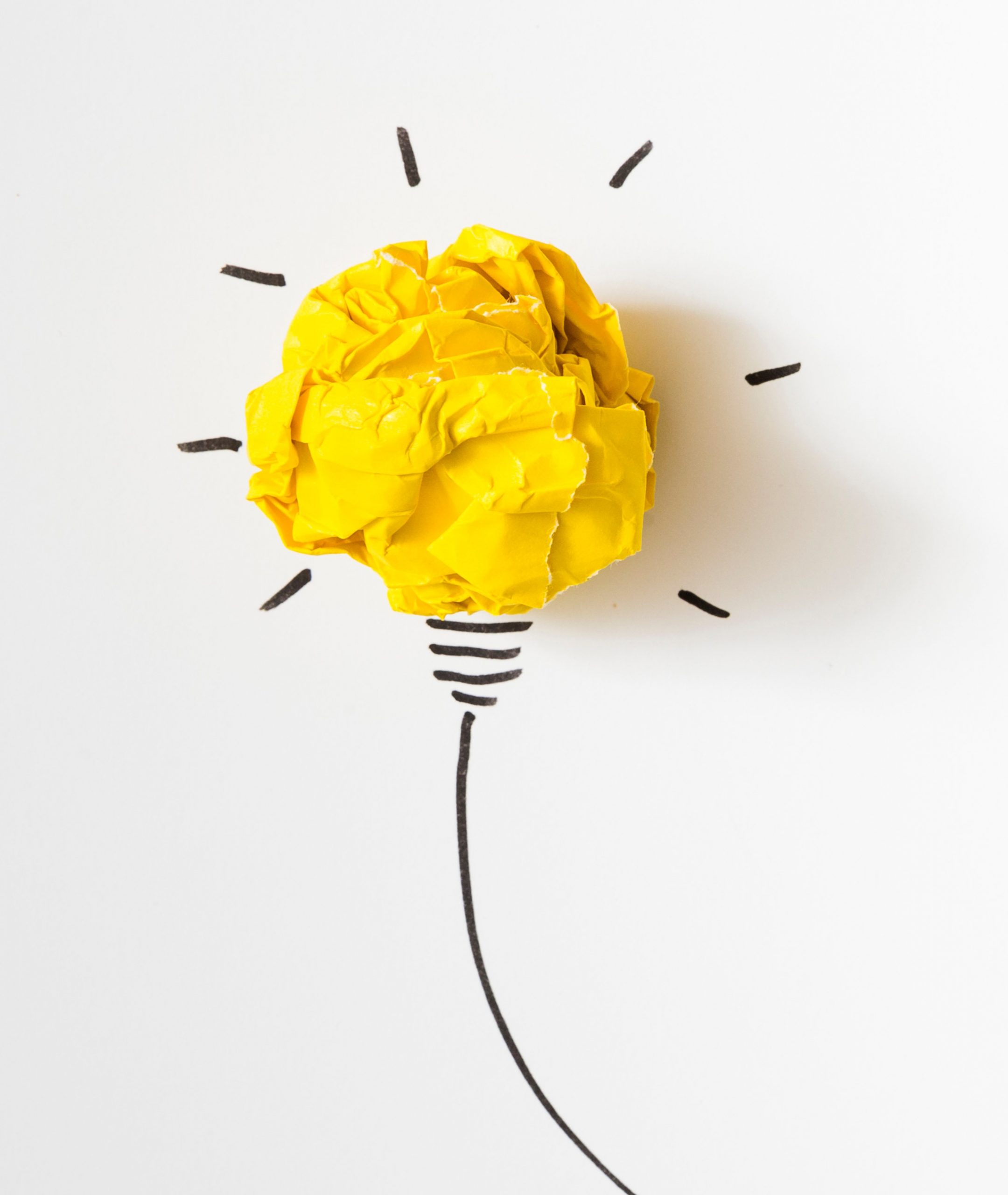 |
You find a great idea in a source, and you want to use it to support your argument. To do this, you need to create an in-text citation and add it to your paper where you have used information from that source, either as a direct quotation or a paraphrased idea. In-text citations tell your reader which ideas belong to you and which ideas belong to someone else.
|
Narrative and Parenthetical Citation
The information for an in-text citation is pulled directly from its matching works cited list entry. It is usually easiest to create the works cited entry first and use it to create an in-text citation. The example below shows a works cited list entry.
Dolmage, Jay Timothy. Academic Ableism: Disability and Higher Education. U of Michigan P, 2017. JSTOR, https://jstor.org/stable/j.ctvr33d50.
There are two different ways you can add an in-text citation to your writing: as a narrative citation, in which the author’s name is part of your sentence, or as a parenthetical citation, in which the citation details are given in parentheses at the end of a phrase or sentence.
Here is a sentence with a narrative citation that matches the works cited list entry above:
Dolmage describes universal design for learning as a way to increase accessibility for everyone (117).
Here is the same sentence, but with a parenthetical citation:
Universal design for learning is a way to increase accessibility for everyone (Dolmage 117).
As the above examples show, an in-text citation includes two key pieces of information:
- Author last name(s) (e.g., Dolmage)
- Page number, or other location within a work (e.g., 117)
Formatting Author Names
The following table shows examples of how to format the author element for in-text citations.
| Author Type |
Formatting |
Example |
| 1 author or editor |
Last Name |
Dolmage |
| 2 authors or editors |
Last Name and Last Name |
Stuessy and Lipscomb |
| 3+ authors or editors |
Last Name et al. |
Kameron et al. |
| Organization or group |
Organization Name |
United Nations Human Settlements Programme |
| No author |
Title of Work |
Room |
Formatting Page Numbers and Other Divisions
The next table shows how to format page numbers and other divisions of works in your in-text citation. For most works, you should use a page number. For poetry or drama, you should usually use line numbers. For works with no page numbers, you might use a chapter, scene, or other division provided in the work. This information should go in parentheses at the end of the words or ideas you are citing. For works without any page numbers or any other division, do not include a number in the parenthetical citation; just follow the guidelines for Formatting Author Names.
| Type of Division |
Example |
| Single page |
117 |
| Page range |
12-13 |
| Line number |
line 72* |
| Chapter |
ch. 3 |
| Scene |
sc. 5 |
*Include the word “line” only the first time you cite the work.
Direct Quotation
So far we have focused on paraphrasing examples. Next we will explore how to cite quotations.
Short Quotations
For a quotation that “runs no more than four lines in your paper” (MLA Handbook, sec. 6.34), incorporate it into your paragraph with quotation marks around it. The following examples are for prose. If you are quoting more than one line of poetry, add a forward slash ( / ) between the lines.
Narrative citation example
Dolmage argues that universal design “is a form of hope, a manner of trying” (116).
Parenthetical citation example
Universal design “is a form of hope, a manner of trying” (Dolmage 116).
Block Quotations
According to the MLA Handbook, “a quotation that runs more than four lines in your prose should be set off from the text as a block indented half an inch from the left margin” (sec. 6.35). The following examples are for a poem, but the rules are the same for prose.
Narrative citation
In Rich’s poem, the narrator’s gender is fluid:
And I am here, the mermaid whose dark hair
streams black, the merman in his armored body.
We circle silently
about the wreck
we dive into the hold.
I am she: I am he (lines 72-77)
Parenthetical citation
The narrator’s gender is fluid:
And I am here, the mermaid whose dark hair
streams black, the merman in his armored body.
We circle silently
about the wreck
we dive into the hold.
I am she: I am he (Rich lines 72-77)
Now that we’ve introduced in-text citations, go to the next section to complete a few in-text citation practice activities.
Image attribution
“Illuminated crumpled yellow paper light bulb idea on white background Free Photo” by Freepik is licensed under Freepik Licence, attribution required.
In-Text Citations Activity
In this section, complete the following three activities to practice creating narrative and parenthetical in-text citations.
Social Media Post
What core elements do you need for an in-text citation using this source? For example: Author, Title of source, or Location, etc…
An interactive H5P element has been excluded from this version of the text. You can view it online here:
https://openeducationalberta.ca/mla-tutorial/?p=71#h5p-16
Creating In-text Citations from Works Cited List Entries
For the next two questions, use the works cited entry to help you fill in in the missing elements of the in-text citation.
Works Cited Entry #1
Walker, Margaret. “The Struggle Staggers Us.” Poetry Foundation, July 1938, www.poetryfoundation.org/poetrymagazine/browse?contentId=22079.
An interactive H5P element has been excluded from this version of the text. You can view it online here:
https://openeducationalberta.ca/mla-tutorial/?p=71#h5p-14
Works Cited Entry #2
Ou, Li. Keats and Negative Capability. Continuum, 2009. EBSCOhost, search.ebscohost.com/login.aspx?direct=true&db=e000xna&AN=306656&site=ehost-live&scope=site.
An interactive H5P element has been excluded from this version of the text. You can view it online here:
https://openeducationalberta.ca/mla-tutorial/?p=71#h5p-15

